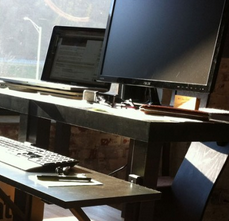Physical Workspace Hacking; 6 tips to create a War Room.

Like any good engineer, I work hard to maximize my impact. Relative to time invested, I want to accomplish as much as possible. So I feel it makes sense to invest some time in organizing my office into my war room.
I have noticed how horrible the workplace organizational skills of some of my cohorts are. Especially engineers. Just because you’re building in the digital world is no excuse to be inept to hacking your personal space. Here are the rules at my war room:
1. Every thing has it’s place.
I have my pencils in a mason jar. My stapler hangs on the wall. My desk has a wicker basket containing arms-reach office supplies. Every item in my space has a container. The container acts as a frame for the item, and this allows my mind to know where to look with minimal conscious effort.
I like to think of the space around me to be organized like a motherboard. Items in my L1 Cache (on my desk) are the fastest to access (within reach). Items in my L2 Cache (my drawers) are quick to access (but I have to bend over). Items that I need less than once a week are neatly organized into their own containers around the room.
Just as everything has it’s place, there too is value in negative space. Negative space is space where my active-task objects are placed. And removed once my task is complete.
If it sounds neurotic, it is. But there is value in having easy access to my tools with minimal conscious effort.
2. Focus is inversely correlated with clutter.
If my brain was a linux box, I’d have a daemon running that removes clutter. Clutter is anything that is occupying negative space in my work area. For example, today I was reading some API documentation. To allow myself to focus on the documents, I placed them in my negative space. They were the only object there while I consumed them. When I was done with the documents, they were put into a file under my desk. Out of sight means out of mind.
Sometimes my anti-clutter daemon falls behind. That’s okay, the key is to focus on as-close-to one thing at a time.
3. Aestheticism is not organization.
When I first started working professionally, I would sometimes confuse aesthetics with organization. Putting all of the objects on a desk at a right angle means you’re neurotic, not organized. Dusting, wiping, or otherwise cleaning means you’re sanitary, not organized.
Organization is about minimizing your conscious effort put towards managing your space such that you can maximize your accomplishments towards your personal objectives.
4. Labeling.
Labels. Put them on all your folders. You’ll be glad you did it when you’re looking for that important file.
5. Manage your time.
How one spends their time is the most important decision one can make. Much ink has been spilled on the topic of time management, and it is largely outside the scope of this post.
That said, I will say that I cannot think of any more important organizational tool than a calendar. I have 4 rules for dealing with my calendar:
- Every meeting must have an objective.
- It’s okay to decline or reschedule a meeting.
- Do a weekly sweep of your priorities and schedule time to tackle the top-line items.
- Do a daily sweep of the next 48 hours; schedule time to prepare for them.
6. Know your organizational anti-patterns.
I have a horrible habit of organizing when I am avoiding work I just don’t want to do.
I can live with that. Right now I just try to be mindful of it and work on my gumption when I notice I am procrastinating.
Maximizing Impact
If there is any hope for all the organizational couch potatoes out there, it’s that organization is a muscle. The more you practice it, the better, faster, stronger you are.
I’ve posted some pictures & a shopping list for my “war room” here. Have a great weekend everyone.
